In the realm of modern landscaping, small garden designs hold a special place. These compact spaces present both challenges and opportunities for imaginative solutions.
In this 10-minute read, we’ll delve into a variety of small garden design ideas you can implement right away on your next project. From maximizing the limited space to choosing the perfect plants, we’ll give you everything you need to make your next small garden design a success.
Let’s start with some low-maintenance small garden design tricks.
Low Maintenance Small Garden Design Tricks
Creating a small garden that’s both beautiful and low maintenance requires a blend of creativity and practicality. Here are some key strategies to achieve this balance:
- Choose Hardy Plants: Opt for species that require minimal care. Drought-tolerant plants, perennials, and native species often need less attention.
- Mulch and Ground Cover: Use mulch to reduce weed growth and retain soil moisture. Ground cover plants can also provide a low-maintenance, visually appealing alternative to grass.
- Automated Irrigation: Implement drip irrigation or a simple timer-based system to reduce the labor of watering.
- Simple Layouts: Design gardens with straightforward layouts and fewer, larger beds to minimize upkeep.
- Quality Over Quantity: Invest in high-quality materials and plants that last longer and require less replacement.
Expert Tip! – Other professional landscapers recommend investing in soil health initially. Healthy soil means healthier plants that require less maintenance in the long run. So at the outset of a landscaping project, test and amend your soil. Conducting a soil test to understand its composition, followed by enriching it with organic amendments like compost, sets the foundation for a thriving garden with minimal future maintenance.
Integrating these low-maintenance strategies can significantly reduce the ongoing care required, making small gardens appealing and manageable for clients.
Small Garden Design Ideas & Inspirational Photos
Every small garden offers a canvas for creative expression. Here are some inspiring design ideas:
1. Combine Seating & Storage
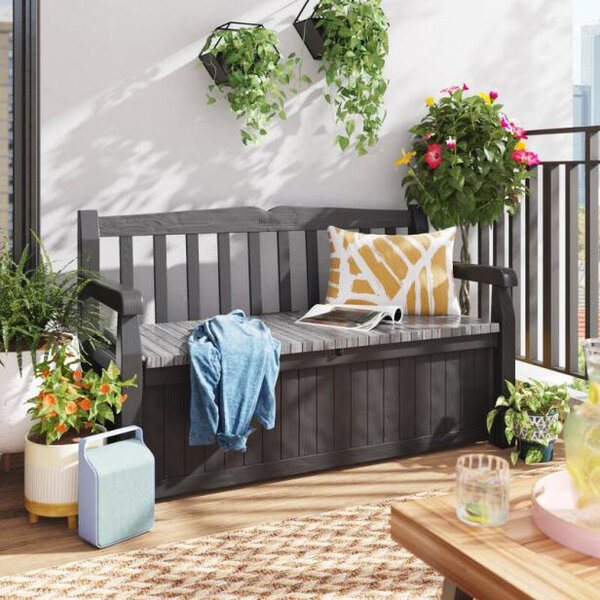
To maximize space in small gardens, try to creatively combine seating with storage. You could design custom-built benches or seats with hidden compartments underneath for storing gardening tools, outdoor games, or seasonal items. Choose durable, weather-resistant materials like teak, cedar, or composite for these dual-purpose furniture pieces to ensure longevity. There are also many purpose-built types of storage seating you can purchase that are ready to use.
You can also save space by incorporating seating areas into the garden’s boundary walls or fences. These seats can double as retaining walls or integrate into raised garden beds. Enhance comfort with weather-resistant cushions, adding color and style to the garden.
Expert Tip! – Tailor the seating design to match the garden’s aesthetic. Go with sleek, minimalist benches in modern gardens, and classic wooden seats with ornate designs in traditional spaces.
2. Opt For Long Flowering Plantings
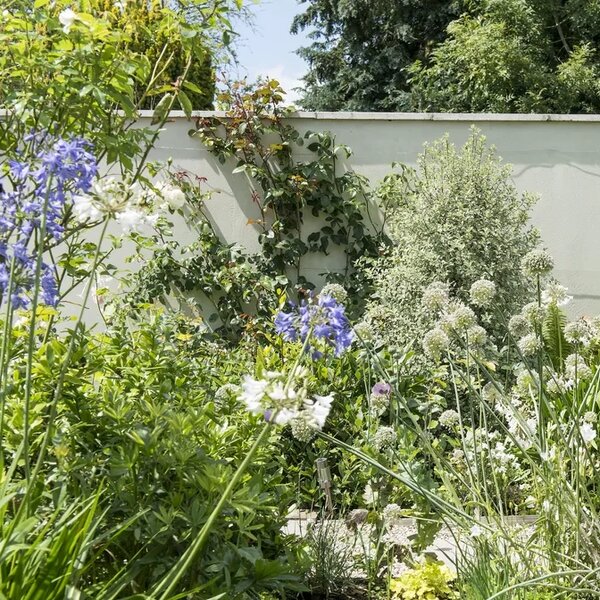
Selecting plants that bloom for extended periods ensures a vibrant garden year-round. Choose perennials like Daylilies, Catmint, and Russian Sage for long-lasting blooms and low maintenance. Mix these with different species to ensure continuous color as they bloom at varying times.
Mixing annuals and perennials can also add instant color. While perennials offer consistency, annuals like Petunias, Marigolds, and Pansies provide a burst of color. Choose plants that complement the garden’s color scheme and overall design.
It’s also good to consider the sensory experience. Fragrant plants like Lavender and Roses add delightful aromas for enhancing the garden’s overall ambiance.
Expert Tip! – Be sure to choose plant combinations that thrive in your local climate and soil. This helps ensure the garden stays colorful and healthy long after you’ve finished the project.
3. Install a Green Wall
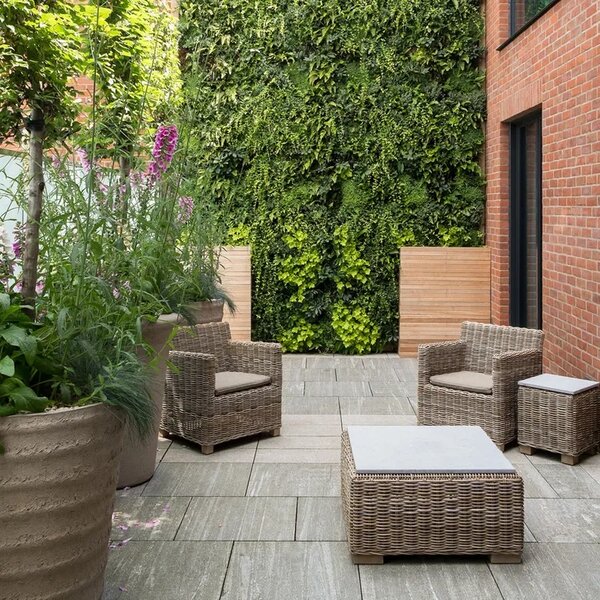
Green walls are both visually stunning and functional. And with their space-saving design, they’re a perfect addition to small garden designs.
You can create them using various systems, from simple trellises with climbing plants to advanced modular systems with built-in irrigation. Choose plants for your green wall considering their light and water needs, growth habits, and maintenance requirements. Ferns, ivies, and certain herb varieties are excellent choices for their adaptability and ease of care.
If you client likes to cook with fresh herbs and spices, consider a vertical herb garden for a more edible approach. This provides fresh herbs for the kitchen while adding a unique element to the garden. Ensure the wall gets adequate sunlight for the chosen plants.
You can also use green walls as living art pieces or natural privacy screens for adding some privacy to your garden.
Cool Idea! – Incorporate elements like LED backlighting to make the wall a focal point, especially in the evenings.
4. Include Hanging Baskets or Planters
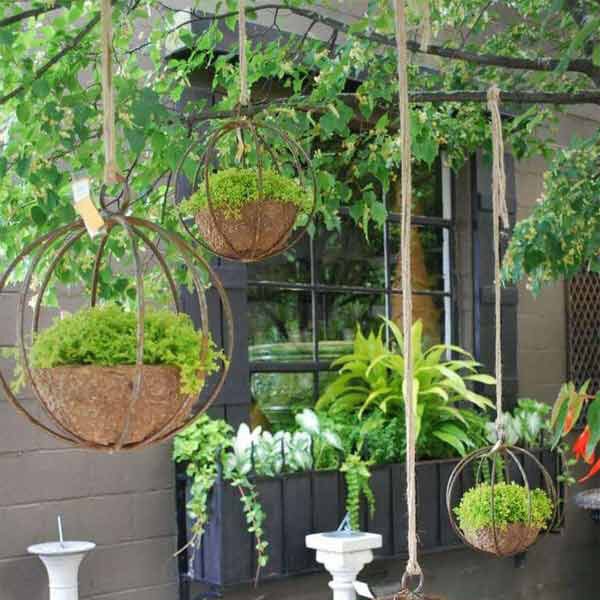
In small gardens, incorporating hanging baskets and planters is a brilliant way to add vertical interest and layers of color without occupying ground space.
Select a variety of plants that spill over the edges for a dramatic effect. Cascading plants like Petunias, Begonias, and Ivy are good chocies. They not only add depth to the garden but also draw the eye upward, creating a sense of space.
When choosing baskets or planters, consider materials that complement the garden’s overall style. For a rustic look, use wooden or wicker baskets. For modern garden designs, go with sleek metal or ceramic planters. And make sure they have adequate drainage to keep plants healthy.
Expert Tip! – Remind your clients to rotate the baskets and planters occasionally to ensure all sides receive equal light for even growth and flowering.
5. Capitalize On Trees
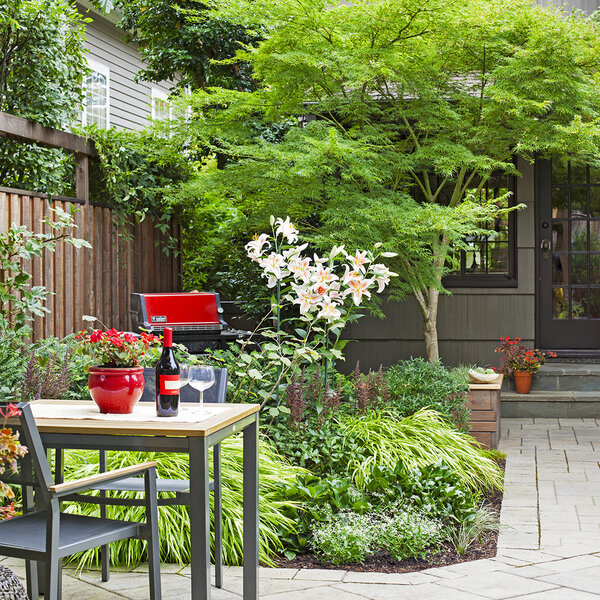
Trees can be magnificent focal points in small gardens. Choose dwarf or slow-growing varieties to avoid overcrowding and ensure they fit the scale of a small garden. Trees not only provide shade and privacy but also add a sense of maturity and permanence to the space.
Consider the tree’s seasonal characteristics when making your selection. Deciduous trees offer shade in summer and allow sunlight in winter. Evergreens provide year-round color and structure. Planting trees in the right location is crucial to avoid issues with roots and shading as they grow.
Expert Tip! – Use trees that bear flowers or fruit to make good use of limited space by adding an extra layer of interest and utility.
6. Add Lighting

Effective lighting can magically transform a small garden into a captivating evening retreat.
- Use LED lights to illuminate pathways, highlight key features or create ambiance.
- Fairy lights strung in trees or across walls add a whimsical touch.
- Spotlights can showcase specific plants or garden elements.
When planning the lighting, consider both functional and aesthetic aspects. Ensure pathways are well-lit for safety, and use softer, warmer lights to create a relaxing atmosphere. Solar-powered lights are an eco-friendly option, reduce electricity usage and are easier to install..
Expert Tip! – Experiment with different lighting levels and positions to find the perfect balance that enhances the garden’s features while creating an inviting atmosphere at night.
But envisioning how the lighting will actually look at night can be challenging during the design process. Fortunately there’s a tool that can help! Learn more in the last section.
Use Landscape Design Software for Small Garden Designs
In today’s fast-paced design world, having the right design tools is crucial. Landscape design software, like Contemporary Style Design, offers immense benefits to professionals like you.
For example, Contemporary Style Design helps you effectively visualize nighttime exterior lighting. This makes it easy for you to simulate various lighting conditions and placements. That enhances your ability to create realistic and immersive outdoor lighting designs. You can even give your clients a preview of how spaces will look after dark.
Imagine how these other benefits can help with your small garden designs!
- Efficiency and Accuracy: Create precise, scalable garden designs quickly. Do in minutes what it used to take days to do.
- 3D Visualization: Present clients with realistic 3D visualizations of the proposed garden, enhancing communication and understanding. Best of all, you don’t need any 3D design experience to get started.
- Easy Modifications: Adjust designs on the fly to accommodate client feedback or site-specific requirements.
Leveraging software like Contemporary Style Design not only saves time but also elevates the quality of your designs, giving you a competitive edge in the small garden design niche.
With a FREE version, you’ve got nothing to lose. Try Contemporary Style Design today!




